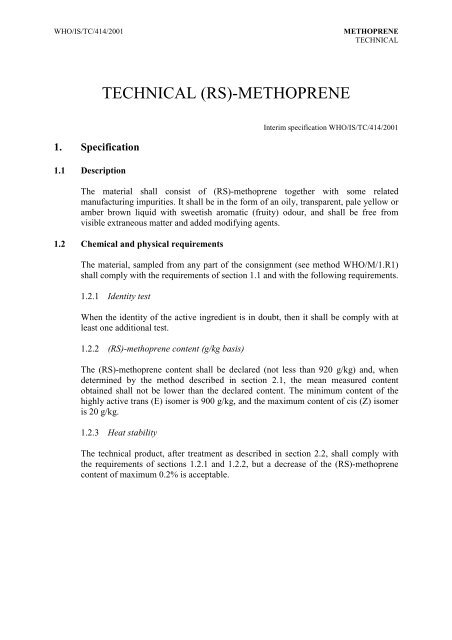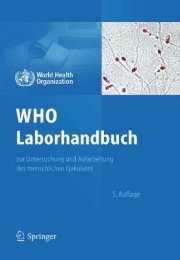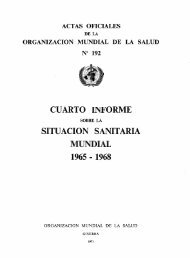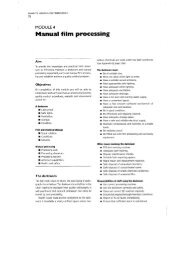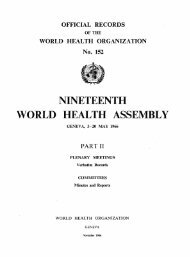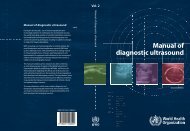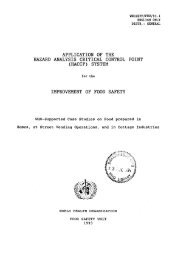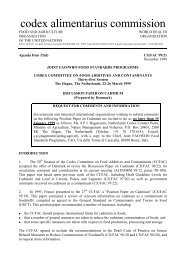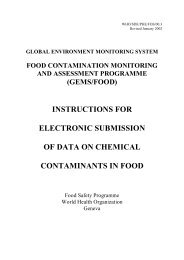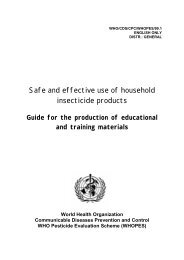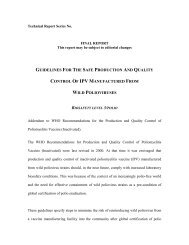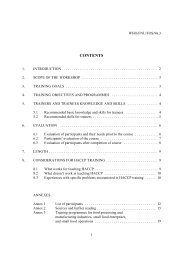TECHNICAL (RS)-METHOPRENE
TECHNICAL (RS)-METHOPRENE
TECHNICAL (RS)-METHOPRENE
You also want an ePaper? Increase the reach of your titles
YUMPU automatically turns print PDFs into web optimized ePapers that Google loves.
WHO/IS/TC/414/2001 <strong>METHOPRENE</strong><br />
<strong>TECHNICAL</strong><br />
1. Specification<br />
1.1 Description<br />
<strong>TECHNICAL</strong> (<strong>RS</strong>)-<strong>METHOPRENE</strong><br />
Interim specification WHO/IS/TC/414/2001<br />
The material shall consist of (<strong>RS</strong>)-methoprene together with some related<br />
manufacturing impurities. It shall be in the form of an oily, transparent, pale yellow or<br />
amber brown liquid with sweetish aromatic (fruity) odour, and shall be free from<br />
visible extraneous matter and added modifying agents.<br />
1.2 Chemical and physical requirements<br />
The material, sampled from any part of the consignment (see method WHO/M/1.R1)<br />
shall comply with the requirements of section 1.1 and with the following requirements.<br />
1.2.1 Identity test<br />
When the identity of the active ingredient is in doubt, then it shall be comply with at<br />
least one additional test.<br />
1.2.2 (<strong>RS</strong>)-methoprene content (g/kg basis)<br />
The (<strong>RS</strong>)-methoprene content shall be declared (not less than 920 g/kg) and, when<br />
determined by the method described in section 2.1, the mean measured content<br />
obtained shall not be lower than the declared content. The minimum content of the<br />
highly active trans (E) isomer is 900 g/kg, and the maximum content of cis (Z) isomer<br />
is 20 g/kg.<br />
1.2.3 Heat stability<br />
The technical product, after treatment as described in section 2.2, shall comply with<br />
the requirements of sections 1.2.1 and 1.2.2, but a decrease of the (<strong>RS</strong>)-methoprene<br />
content of maximum 0.2% is acceptable.
WHO/IS/TC/414/2001 <strong>METHOPRENE</strong><br />
<strong>TECHNICAL</strong><br />
1.3 Packing and marking of packages<br />
The technical (<strong>RS</strong>)-methoprene shall be packed in suitable clean containers as<br />
specified in the order.<br />
All packages shall bear, durably and legibly marked on the container the following:<br />
Manufacturer’s name<br />
Technical (<strong>RS</strong>)-methoprene (920 g/kg)<br />
Batch or reference number and date of test<br />
Net weight of contents<br />
Date of manufacture<br />
and the following minimum cautionary notice:<br />
(<strong>RS</strong>)-methoprene is an insect growth regulator, a juvenile hormone analogue (juvenoid)<br />
preventing insect metamorphosis to viable adults when applied to larval stages. Not known to<br />
cause adverse effect by ingestion, inhalation and contact of skin but may irritate eyes.<br />
Keep the material out of reach of children and away from foodstuffs and animal feed and their<br />
containers.<br />
First aid measures:<br />
Ingestion: Do not induce vomiting, get medical attention.<br />
Eye contact: Flush with large amounts of water.<br />
Skin contact: Wash with soap and water.<br />
2. Methods of determining chemical and physical properties<br />
2.1 Methoprene content<br />
2.1.1 Outline of method<br />
The determination of the active ingredient content in (<strong>RS</strong>)-methoprene technical is<br />
carried out by gas chromatography ( GC ), using the total area method.<br />
The constituents are separated by GC on a methyl siloxane capillary column and<br />
detected by flame ionization.<br />
2.1.2 Apparatus<br />
1. Gas-liquid chromatograph. Hewlett Packard 6890 GC with a HP 3398 GC<br />
Chemstation software or equivalent<br />
2. Chromatographic column. Capillary column 30 m long, 0.25 mm internal<br />
diameter, 0.25 µm film thickness, filled with methyl siloxane (Type: HP-1) or<br />
equivalent<br />
Before use, condition a new column by purging with nitrogen overnight at about<br />
280 °C. During this operation the column must not be connected to the detector<br />
to avoid contamination by " initial bleed " of the stationary phase.<br />
Page 2 of 9
WHO/IS/TC/414/2001 <strong>METHOPRENE</strong><br />
<strong>TECHNICAL</strong><br />
2.1.3 Operating conditions for gas chromatography<br />
The conditions given below are typical values and may have to be adjusted to obtain<br />
optimum results from a given apparatus.<br />
Temperatures<br />
Column oven 170°C 10°C/min. 240 °C (10 min.)<br />
Injector 250 °C<br />
Detector: 300 °C<br />
Gas flow rates<br />
Carrier gas: N 2 : 1.7 mL/min.<br />
Hydrogen and air: H 2 : 30 mL/min.<br />
Air: 400 mL/min.<br />
Make-up: N2 25 mL/min.<br />
Septum purge: 3.0 mL/min.<br />
Split ratio: 1:100<br />
Typical retention times:<br />
cis-methoprene: ~5,6 min.<br />
trans-methoprene: ~6.1 min.<br />
Injected volume: 1 µL<br />
2.1.4 Sample preparation and analysis<br />
Sample solution. Prepare a 1% solution with ethanol. Weigh approximately 0.5 g of<br />
sample in a 5 mL volumetric flask, dissolve in ethyl alcohol and fill to volume.<br />
2.1.5 Chromatographic method<br />
Inject 1 µL of the sample solution three times in succession. The differences between<br />
the peak areas for the three injections must not exceed 2%. If not repeat the sequence.<br />
2.1.6 Calculation<br />
The percentage composition of each peak is determined by GC software using the total<br />
area method.<br />
Page 3 of 9
WHO/IS/TC/414/2001 <strong>METHOPRENE</strong><br />
<strong>TECHNICAL</strong><br />
2.2. Heat stability treatment<br />
54°C ± 2°C for 14 days ( CIPAC method MT 46.1, CIPAC Handbook F, p.149) unless<br />
other temperatures and times are requested ( FAO Manual on the development and<br />
use of FAO specifications for plant protection products, n°149, p.33).<br />
After completion of the heat stability treatment, the samples should not be exposed to<br />
heat, bright sunshine or atmospheric humidity.<br />
If required the test should de conducted in the commercial type pack.<br />
Page 4 of 9
WHO/IS/EC/414/2001 ( <strong>RS</strong> ) <strong>METHOPRENE</strong><br />
EMULSIFIABLE CONCENTRATE<br />
1. Specification<br />
1.1 Description<br />
(<strong>RS</strong>)-<strong>METHOPRENE</strong><br />
EMULSIFIABLE CONCENTRATE<br />
Page 5 of 9<br />
Interim specification WHO/IC/EC/414/2001<br />
The material shall consist of technical (<strong>RS</strong>)-methoprene, complying with the<br />
requirements of the WHO specification WHO/IS/TC/414/2001, dissolved in suitable<br />
solvents, together with other necessary formulants. It shall be in the form of a stable,<br />
homogeneous liquid with slight petroleum odour, free from visible suspended matter<br />
and sediment, to be applied as an emulsion after dilution in water.<br />
1.2 Chemical and physical requirements<br />
The material sampled from any part of the consignment (see method WHO/M/1.R1),<br />
shall comply with the requirements of section 1.1 and with the following requirements.<br />
1.2.1 (<strong>RS</strong>)-methoprene content (g/kg basis)<br />
The content of (<strong>RS</strong>)-methoprene determined by the method described in section 2.1<br />
shall not differ from the declared content by more than the following amounts:<br />
Declared content Tolerance permitted<br />
Up to 25 g/kg + 15 % of the declared content<br />
Above 25 up to 100 g/kg + 10 % of the declared content<br />
Above 100 up to 250 g/kg + 6 % of the declared content<br />
The average content of all samples taken shall not be lower than the declared content.<br />
1.2.2 Water content<br />
The water content determined by the method WHO/M/7.R1, shall not be higher than<br />
1.6 g/kg.<br />
1.2.3 Acidity<br />
The acidity determined by the CIPAC method MT 31 (CIPAC Handbook F, p. 96)<br />
shall not be higher than 0.1 g/kg calculated as H2SO4.
WHO/IS/EC/414/2001 ( <strong>RS</strong> ) <strong>METHOPRENE</strong><br />
EMULSIFIABLE CONCENTRATE<br />
1.2.4 Cold test<br />
No separation of solid or oily material shall occur when the concentrate is tested as<br />
described in CIPAC method MT 39 ( CIPAC Handbook F, p.128 ).<br />
1.2.5 Flash point<br />
The flash point of the product, determined by the CIPAC method MT 12 ( CIPAC<br />
Handbook F, p.31) shall not be lower than 66 o C and shall comply with all national<br />
and/or international transport regulations.<br />
1.2.6 Stability of the emulsion<br />
In WHO standard soft water. Any separation, including creaming/oiling at the top and<br />
oiling/sedimentation at the bottom, of 100 mL of emulsion prepared in WHO standard<br />
soft water (WHO/M/29) with 5 mL of concentrate shall not be present when tested as<br />
described in WHO/M/13.R4.<br />
In WHO standard hard water. Any separation including creaming/oiling at the top and<br />
oiling/sedimentation at the bottom, of 100 mL of emulsion prepared in WHO standard<br />
hard water (WHO/M/29) with 5 mL of concentrate shall not exceed 2 mL when tested as<br />
described in WHO/M/13.R4.<br />
1.2.7 Persistent foam<br />
In WHO standard soft water: When tested by the CIPAC method MT 47.2 (CIPAC<br />
Handbook F, p.152 ) a maximum of 60 mL of foam shall be observed after 1 minute.<br />
1.2.8 Heat stability<br />
The concentrate, after treatment as described in section 3.1, shall comply with the<br />
requirements of sections 1.2.1, 1.2.3 and 1.2.6 of this specification.<br />
1.3 Packing and marking of packages<br />
The (<strong>RS</strong>)-methoprene emulsifiable concentrate shall be packed in suitable clean<br />
containers, as specified in the order.<br />
All packages shall bear, durably and legibly marked on the container the following:<br />
Manufacturer’s name<br />
(<strong>RS</strong>)-methoprene emulsifiable concentrate<br />
(<strong>RS</strong>)-methoprene (....g/kg)<br />
Batch or reference number and date of test<br />
Net weight of contents<br />
Instructions for use<br />
Date of manufacture<br />
Page 6 of 9
WHO/IS/EC/414/2001 ( <strong>RS</strong> ) <strong>METHOPRENE</strong><br />
EMULSIFIABLE CONCENTRATE<br />
and the following minimum cautionary notice:<br />
(<strong>RS</strong>)-methoprene is an insect growth regulator, a juvenile hormone analogue (juvenoid)<br />
preventing insect metamorphosis to viable adults when applied to larval stages. Not known to<br />
cause adverse effect by ingestion, inhalation and contact of skin but may irritate eyes.<br />
Keep the material out of reach of children and away from foodstuffs and animal feed and their<br />
container.<br />
First aid measures:<br />
Ingestion: Do not induce vomiting, get medical attention.<br />
Eye contact: Flush with large amounts of water.<br />
Skin contact: Wash with soap and water.<br />
2. Methods of determining chemical and physical properties<br />
2.1 Methoprene content<br />
2.1.1 Outline of method<br />
The determination of the active ingredient content in (<strong>RS</strong>)-methoprene EC formulations<br />
is carried out by gas chromatographic method, using an internal standard solution<br />
containing eicosane.<br />
The formulation is separated by GC on a methyl siloxane capillary column and detected<br />
by flame ionization..<br />
2.1.2 Apparatus<br />
1. Gas-liquid Chromatograph. Hewlett Packard 6890 GC with a HP 3398 GC<br />
Chemstation software or equivalent<br />
2. Chromatographic Column. Capillary column 30 m long, 0.25 mm internal<br />
diameter, 0.25 µm film thickness, filled with methyl siloxane (Type: HP-1) or<br />
equivalent<br />
Before use condition a new column by purging with nitrogen overnight at about<br />
280 °C. During this operation the column must not be connected to the detector<br />
to avoid contamination by " initial bleed " of the stationary phase.<br />
2.1.3 Reagents<br />
Methoprene standard. Analytical grade, of known purity stored under 10 °C.<br />
Internal standard. Eicosane, free from components which should co-elute with<br />
methoprene under the chromatographic conditions given in section 2.1.5.<br />
2.1.4 Preparation of standard solutions<br />
Page 7 of 9
WHO/IS/EC/414/2001 ( <strong>RS</strong> ) <strong>METHOPRENE</strong><br />
EMULSIFIABLE CONCENTRATE<br />
Internal standard solution. Weigh 1.0 g of eicosane, dissolve in ethyl alcohol and make<br />
up to 250 mL in a volumetric flask.<br />
Methoprene standard solution. Weigh approx. 50 mg standard methoprene in a 25 mL<br />
volumetric flask, dissolve in ethyl alcohol, then add 5 mL of internal standard solution by<br />
pipette and fill to volume.<br />
2.1.5 Operating conditions for gas chromatography<br />
The conditions given below are typical values and may have to be adjusted to obtain<br />
optimum results from a given apparatus.<br />
Temperatures<br />
Oven 170°C 10°C/min. 240 °C (10 min.)<br />
Injection port 250 °C<br />
Detector: 300 °C<br />
Gas flow rates<br />
Carrier gas: N 2 : 1.7 mL/min.<br />
Hydrogen and air: H 2 : 30.0 mL/min.<br />
Air: 400.0 mL/min.<br />
Make-up: N2 25.0 mL/min.<br />
Septum purge: 3.0 mL/min.<br />
Split ratio: 1:100<br />
Approximate retention times:<br />
Eicosane: ~5.5 min.<br />
Methoprene: ~6.1 min.<br />
Injected volume 1 µL<br />
2.1.6 Sample preparation.<br />
Sample solutions. Ensure that samples are homogeneous by equilibrating to room<br />
temperature and mixing thoroughly. Weigh approximately 0.5 g of sample in a 25 mL<br />
volumetric flask, dissolve in ethyl alcohol, then add 5 mL of the internal standard<br />
solution by pipette and fill to volume.<br />
2.1.7 Chromatographic method<br />
Inject 1 µL of the standard solution three times in succession, then calculate the<br />
proportion of peak area of methoprene and eicosane.<br />
The differences between the proportions of peak area received for the three injections<br />
must not exceed 2 %. Afterward, inject three times of the sample solution, and proceed<br />
as for the standard.<br />
Page 8 of 9
WHO/IS/EC/414/2001 ( <strong>RS</strong> ) <strong>METHOPRENE</strong><br />
EMULSIFIABLE CONCENTRATE<br />
2.1.8 Calculation<br />
Active ingredient % =<br />
Am x Mstd x T<br />
Astd x Mm<br />
Am = ratio of the under-peak area of methoprene and eicosane in the sample<br />
Astd = ratio of the under-peak area of methoprene and eicosane in the standard<br />
Mm = mass of the sample (in grams)<br />
Mstd = mass of the standard (in grams)<br />
T = purity of the standard (in %)<br />
3.1 Heat stability treatment<br />
54°C ± 2°C for 14 days ( CIPAC method MT 46.1, CIPAC Handbook F, p.149 ),<br />
unless other temperatures and times are requested ( FAO Manual on the development<br />
and use of FAO specifications for plant protection products, n° 149, p.33 ).<br />
After completion of the heat stability treatment, the samples should not be exposed to<br />
heat, bright sunshine , or atmospheric humidity.<br />
If required the test should be conducted in the commercial type pack.<br />
Page 9 of 9


